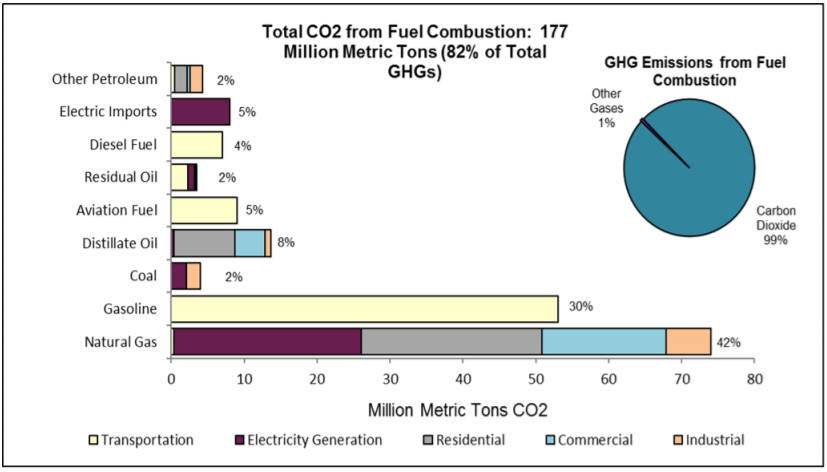New climate law, new opportunities for gas supply planning in New York
 By Natalie Karas and Erin Murphy
By Natalie Karas and Erin Murphy
New York recently enacted one of the most ambitious climate targets in the country. The Climate Leadership and Community Protection Act requires an 85% reduction in statewide greenhouse emissions by 2050 (from 1990 levels). All state agencies — including the New York Public Service Commission, which oversees utility companies — must now assess whether every decision they issue will, or will not, interfere with those emissions goals.
Meeting this bold new standard will depend heavily on the state’s natural gas utilities. That’s because residential and commercial heating are major contributors to the state’s greenhouse gas footprint. Unfortunately, utility companies today are continuing to rely on old assumptions, programs and ideas when making multi-billion dollar infrastructure investments that will last for decades. If allowed to continue, these investments will significantly hinder the state from meeting its climate goals, while locking in expensive and potentially unnecessary infrastructure for decades to come.
At the starting line
Let’s take stock of where the state is currently in meeting its prior goal of reducing greenhouse gas emissions 80% by 2050. According to a 2018 report, the state’s total greenhouse gas emissions in 1990 were about 238 million metric tons.

An 80% reduction by 2050 would equal 48 million metric tons. But in 2015, greenhouse gas emissions associated with natural gas alone totaled over 76 million metric tons – already far more than the 48 million metric tons that can be allowed economy-wide in 2050. Clearly we have a long way to go.
New climate law, new opportunities for gas supply planning in New York Share on XDisconnect between natural gas policies, climate goals
Gas utilities have a critical role to play in ensuring New York meets its ambitious climate goals.
Consider Con Edison’s recent rate request to the PSC proposing over 60 natural gas projects and other programs totaling $2.9 billion in capital investments over the next three years. These costs are generally paid off over the expected “useful life” of the infrastructure. For example, ConEd proposes to recover the cost of new gas mains over 80 years, without any demonstration as to how that proposal would impact the state’s climate policies.
ConEd has also signed up for 20 years of gas transportation service on the $3.5 billion Mountain Valley Pipeline, which some estimate will ultimately generate nearly 90 million metric tons of emissions — the equivalent of 19 million passenger vehicles.
While some of this investment may be necessary in the short term, there is not a true accounting of the costs to ratepayers since these investments may not provide value over the lifetime of the infrastructure. The sensible solution is for gas utilities and their regulators to provide the transparent means to assess and weigh the true financial cost of these investments in the context of meeting New York’s climate goals.
Tools to reduce gas system emissions
There are a number of solutions that can help set New York on a path toward meeting its climate goals in a timely manner. Here are four:
• Create more transparency and access: The gas supply planning process should be more open, as EDF recently asserted in testimony to the New York PSC. Decision makers and the public need a better handle on the true needs of the gas system, as well as the actual all-in costs of each alternative. Utilities should be required to provide detailed information on their gas demand projections and how they plan to meet those needs. Options should encompass non-pipeline alternatives, such as demand response, energy efficiency, and ground and air source heat pumps.
• Demonstrate compliance with climate goals: Gas utilities should be required to demonstrate that major infrastructure proposals will not interfere with New York’s greenhouse gas emission goals, as is required under the CLCPA. Without accurate information and analyses from the utility, state regulators can’t assess whether their approval of projects and requests is consistent with the new law.
• Address methane leaks: Methane is a potent greenhouse gas responsible for about a quarter of the warming we’re experiencing today. It’s also the principal ingredient in natural gas. Reducing the amount of methane leaking from the natural gas system is a crucial opportunity to slow the rate of warming now, even as we continue to decarbonize the energy system as a whole. We first need an accurate inventory of methane leaks. Utilities have successfully shown that advanced leak detection technology and analytics can find many more existing and ongoing leaks than traditional methods such as walking surveys, which can often miss relatively large leaks. We also need to refine the current incentive structures, which reward utilities primarily for reporting a lower number of leaks. While advanced leak detection technology can find many more leaks (which would add to a utility’s backlog), utilities may be reluctant to adopt such technology if they are rewarded solely for reducing the number of leaks in their backlog. Utilities should be incentivized to find more leaks using advanced leak detection, estimate the flow rate (i.e., liters of methane per minute) and reduce those leaks by prioritizing the highest volume leaks first.
• Retiring leak-prone pipe: Utilities around the country have thousands of miles of aging gas lines made from cast iron and other leak-prone materials. Replacing this plumbing is costly; for example, Central Hudson Gas & Electric estimates an average of $1.9 million per mile. Deliberate planning to retire gas infrastructure is necessary, including strategies to increase the adoption of heating electrification (e.g. air source and ground source heat pumps). Where feasible, safe and cost effective, utilities should consider permanently retiring sections of leak prone pipe if customers are able to convert to alternate forms of energy (as Central Hudson recently proposed and as Massachusetts is currently studying).
New York should be proud of the bold action its legislature recently took to set limits on the Empire State’s greenhouse gas emissions. Now it’s time to roll up our sleeves and make sure we have the tools in place to meet these goals.
Erin Murphy is an attorney for energy markets and regulation.










